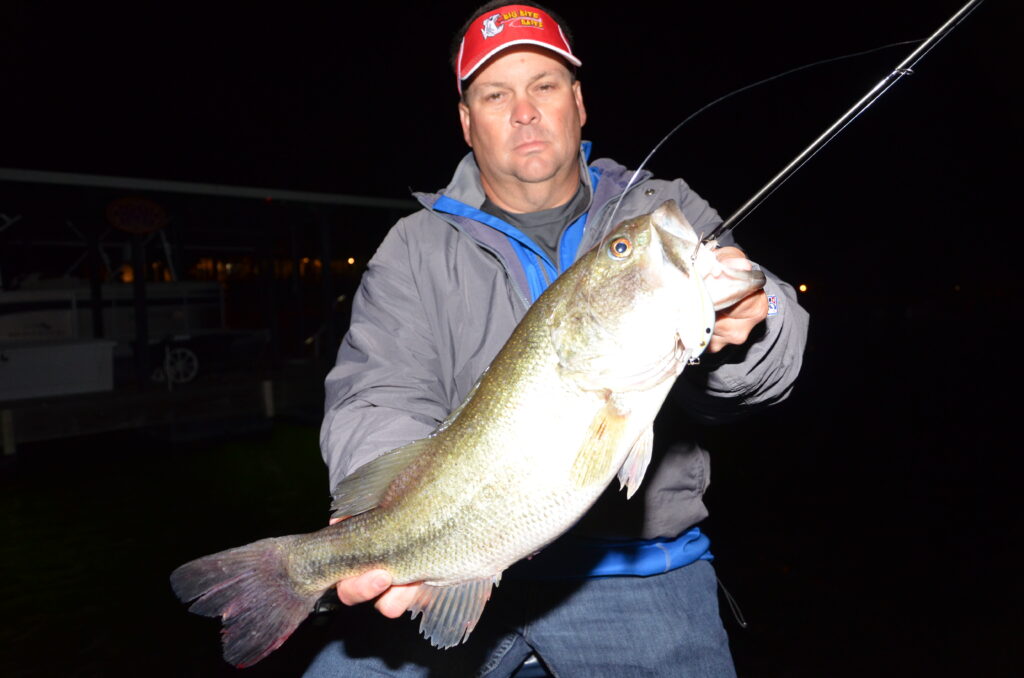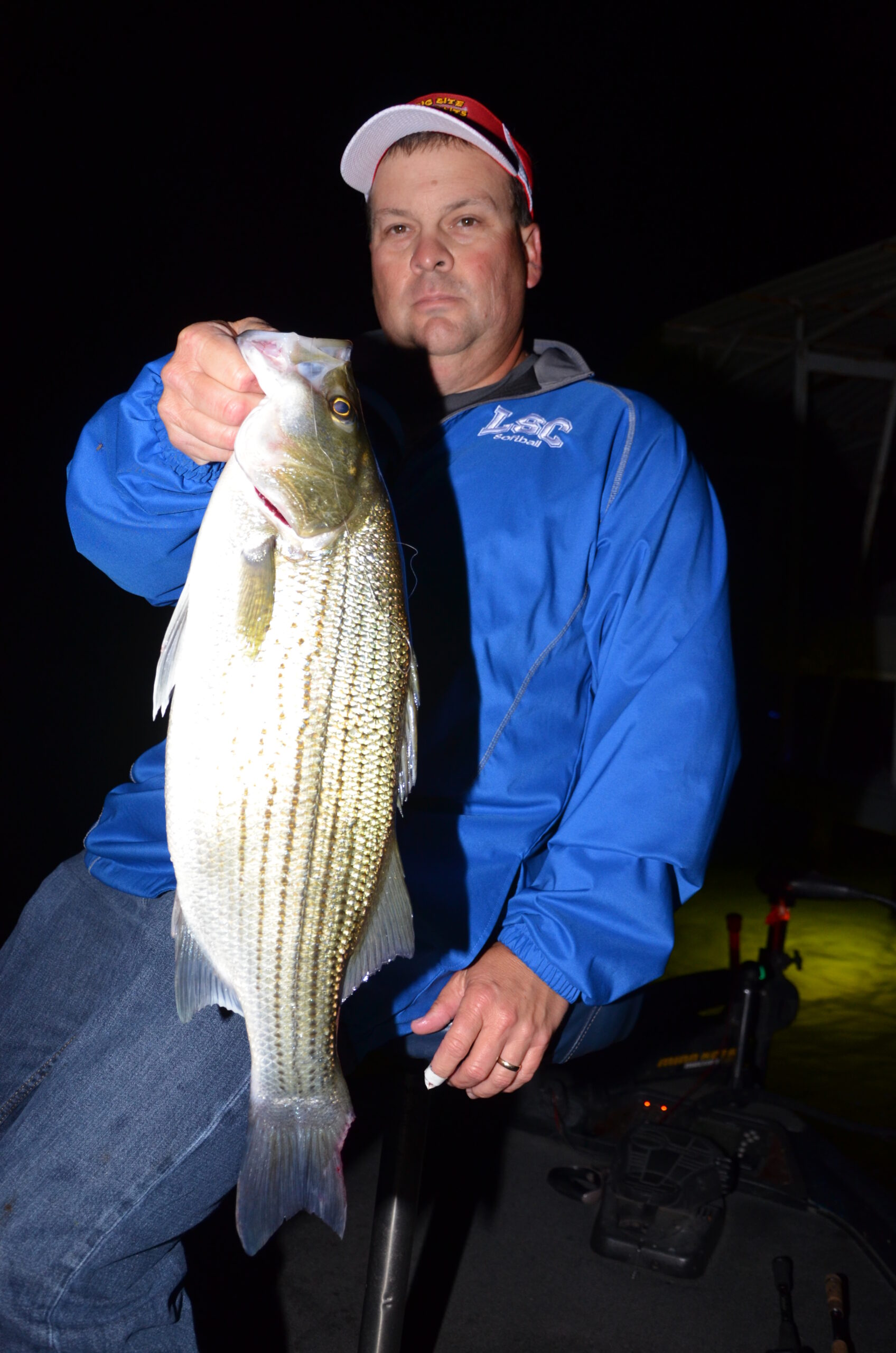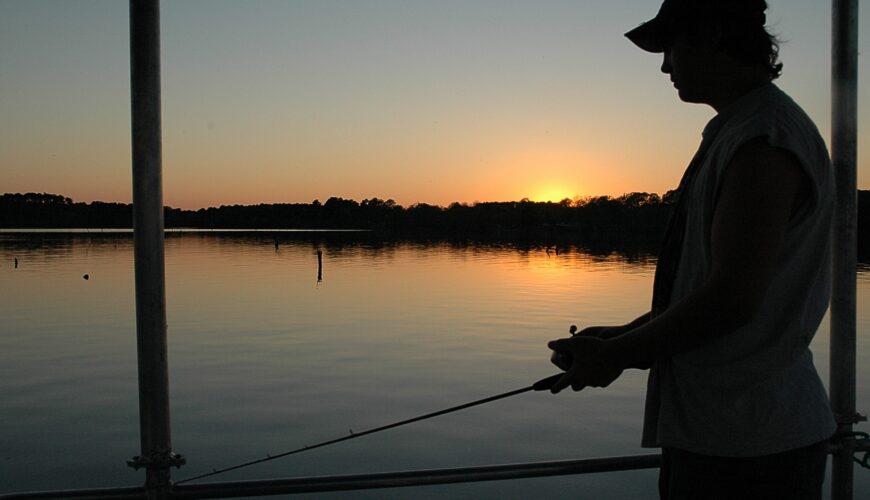Tactics
National Deer Association’s 5 Top Tips for Late-Season Deer Hunting
December 17, 2025 •iSportsman Staff
August 27, 2025
Several black specters flashed in front of the glowing green orbs and vanished just as quickly as they appeared. Slowly, cautiously, we moved closer to investigate the apparitions.
No, we didn’t chase paranormal phantoms emanating from the lake on this night. We concentrated on catching more mundane creatures, lunker largemouth and hybrid striped bass.
On many public waters, bass endure a daily pounding from multiple lure types. During warmer months, flotillas of jet skis, water skiers and other recreational boaters churn the surface. At night, however, fewer anglers and almost no recreational boaters venture out. In the quiet darkness, giant bass lose a bit of their natural wariness and might strike any lures more aggressively.
“A girl fishing with me one night caught a bass weighing 11.25 pounds,” proclaimed David Pair, a fisherman from Abbeville, Ala. “We lost some fish that would have made that one look small. Her best five probably went about 35 pounds.”
The best night fishing typically occurs near docks, marinas, bridges and other areas with lights. Many property owners install lights to shine over the water off the ends of their docks. Light gathers plankton, which attracts shad, minnows and other small creatures. In addition, lights attract insects. Inevitably, some fall into the water where bream and other fish devour them. Largemouths, hybrid striped bass, slab crappie and other predators gather to eat the small fish.
“Lights kick start the whole food chain,” Pair explained. “Those lights always have fry, minnows, shad or other small fish around them. Big bass are far more nocturnal by nature anyway.”
Most nocturnal anglers naturally gravitate toward docks with lights hanging over the water. Those highly visible illuminations can produce excellent action, but anyone can spot them from miles away. Anglers can’t see underwater lights as easily, but fish find them with no problem. Since fewer people can locate underwater lights, they don’t receive as much pressure. During the daylight, nobody can find them unless they snag one.
“People can see overhead lights from across the lake, but people who don’t know what to look for will not see underwater lights,” Pair commented. “From a distance, the water just looks like something reflecting off it. The more stained the water is, the harder underwater lights are to spot. Even in stained water, we can usually catch fish off underwater lights unless the water turns too muddy.”
In addition, lights shining from above don’t penetrate the water as deeply. They also create some glare so fish can’t see baits as easily. Moreover, overhead lights attract more bugs, the bane of all night fishermen. Underwater lights don’t attract nearly as many mosquitoes.
“Underwater lights are sealed, weighted on the bottom and shining upward toward the surface,” Pair said. “With lights shining upward, bass and other fish can see their prey a little better. Anglers can watch the water and see fish activity around the lights. It’s like watching fish in an aquarium when the water is clear.”
Pair motored across the choppy lake toward the gloomy black line punctuated by a few bright points. Soon, a boathouse dock loomed out of the cloaking blackness, but we still could not see the submerged green illumination until almost on top of it. He shut off the outboard some distance from the glow and dropped in the trolling motor.
We approached slowly and quietly, watching fishy silhouettes darting through the illuminated water. At extreme casting distance, we each tossed shad-pattern crankbaits toward the green glow. Almost immediately, we both hooked up, one with a largemouth bass and the other a hybrid.

David Pair shows off a largemouth bass he caught on a crankbait while fishing around lighted docks at night on Lake Eufaula. John N. Felsher Photo
“When we throw a bait around a light at night, we never know what we might catch,” Pair quipped. “It might be a big largemouth, a hybrid striped bass, a white bass or an occasional catfish. I’ve caught crappie exceeding 2.5 pounds while fishing big crankbaits around the lights. Sometimes, we’ll catch huge striped bass. Fishing around underwater lights at night increases the chances of catching many different fish species.”
Like in any fishing situation, some lights consistently produce more or bigger fish than others. Some lights hold mostly hybrids or largemouths. Some attract more varieties. Some attract varied species during different seasons. Anglers fishing any lake need to experiment to determine the best times and conditions to fish certain lights for their favorite species. In general, look for lights that give fish access to deep water and hold good baitfish.
“When I want to catch big largemouth, I look for shad about the size of my hand swimming around the lights,” Pair detailed. “Then, any shad pattern will work, but my favorite is Sexy Shad. If the crankbait bite shuts down or the fish turn finicky, I might go back over the area with a big dark-colored worm. Sometimes, I’ll throw a weightless fluke whenever the fish turn really finicky.”
Since bass and hybrids routinely feed upon shad, Pair typically throws large crankbaits in shad patterns. He likes Strike King KVD 2.5 or 6XD series lures. Sometimes, he casts large, shad-pattern swimbaits. Bass also eat bream, so enticements that mimic bluegills also tempt lunkers at night.
Baits that resemble shad work equally well for both largemouth and hybrids. When specifically fishing for white or hybrid bass, move lures a little faster. Fish baits slower and more erratically when targeting largemouths. Sometimes, fish hang near the transition zone from light to darkness. At other times, they hold tight to the lights. Thoroughly probe each area. Fan cast around the lights to determine where fish prefer to hunt at that time.
“Sometimes, a light looks like a racetrack with fish swimming around it,” Pair described. “The water will be nothing but black silhouettes with fish moving around constantly. When that happens, we can catch fish on just about every cast until we get tired of catching them.”
Underwater high-voltage lights radiate heat. That heat could slightly warm surrounding water on a chilly night. Just a slight temperature increase could make a big difference to frosty cold-blooded fish. On the other hand, fish seek cooler water during the summer and could shy away from hotter lights. Low-voltage LED underwater lights give off little heat, making them outstanding for fishing in warmer water.
These techniques could work on any lakes with docks, boathouses or other structures holding lights. Just look for the glowing orbs and flashes under the water.
Several dark shapes darted past luminous green glows, vanishing as swiftly as they appeared. With care, we moved closer to investigate these spectral forms—not apparitions, but rather trophy largemouth and hybrid striped bass.
On many public lakes, bass endure heavy fishing pressure from a variety of lures. Warm months bring flotillas of jet skis, water skiers, and pleasure boaters, but once night falls, the crowds disappear. In the quiet darkness, the largest bass become less cautious and strike lures more aggressively.
“A girl fishing with me one night caught a bass weighing 11.25 pounds,” recalled David Pair, an angler from Abbeville, Alabama. “We lost some fish that would have dwarfed hers. Her best five likely totaled about 35 pounds.”
Prime night fishing usually occurs near docks, marinas, bridges, and other structures illuminated by lights. Many property owners mount lights at the ends of their docks, casting a glow over the water. These lights attract plankton, which brings in shad, minnows, and other small prey. They also draw insects, some of which fall into the water and become food for bream and other fish. This, in turn, attracts predators like largemouth bass, hybrid striped bass, slab crappie, and more.
“Lights kick start the whole food chain,” Pair explained. “Lights always bring in fry, minnows, shad, or other baitfish. Big bass are naturally more nocturnal anyway.”
Many night anglers target docks lit from above, which are visible from far away. However, underwater lights are much less obvious to people but easily found by fish, offering less competition and pressure. During the day, these submerged lights are nearly invisible unless someone accidentally snags one.
“People can see overhead lights from across the lake, but unless you know what to look for, you won’t spot underwater lights,” said Pair. “From a distance, it just looks like a reflection. The murkier the water, the harder it is to see underwater lights. Even still, except in very muddy water, we usually catch fish from these spots.”
Overhead lights do not penetrate deeply into the water and can create glare, making it harder for fish to spot bait. They also attract more insects, a nuisance for anglers. Underwater lights, by contrast, attract fewer mosquitoes.
“Underwater lights are sealed, sit on the bottom, and shine upward,” Pair continued. “With the light directed upward, bass and other fish spot their prey more easily, and anglers can see fish darting around the glow. It’s like watching fish in an aquarium when the water is clear.”
Pair guided the boat across a choppy lake, heading for a dark shoreline punctuated by a few bright dots. As a boathouse dock appeared from the gloom, the submerged green light was only visible up close. He switched off the outboard and eased in quietly with the trolling motor.
Moving in slowly, we watched fish silhouettes dart through the illuminated water. From a long cast away, we each threw shad-pattern crankbaits toward the glow and almost instantly hooked up—a largemouth for one, a hybrid for the other.
“When we fish around a light at night, we never know what will bite,” Pair joked. “It might be a big largemouth, a hybrid striped bass, a white bass, or even a catfish. I’ve caught crappie over 2.5 pounds on big crankbaits around these lights, and sometimes, huge striped bass. Underwater lights at night boost your chances of catching all kinds of species.”

When you fish around a light at night, you never know what will bite, but chances are it will be big. John N. Felsher Photo
As with any fishing, some lights consistently yield more or bigger fish. Some attract mostly hybrids or largemouths, others multiple species or different fish at different times of year. Anglers must experiment to find the best lights for their target species, focusing on those near deep water and abundant baitfish.
“When I’m after big largemouth, I look for hand-sized shad swimming around the lights,” Pair said. “Any shad-pattern works, but I like Sexy Shad. If crankbaits stop working or fish get finicky, I’ll try a large dark-colored worm or a weightless fluke.”
Because bass and hybrids feed heavily on shad, Pair prefers large, shad-pattern crankbaits like the Strike King KVD 2.5 or 6XD, or big shad-pattern swimbaits. Since bass also eat bream, lures mimicking bluegill can tempt them at night.
Shad imitations work well for both largemouth and hybrids. For white or hybrid bass, retrieve lures faster, while a slower, erratic presentation works for largemouths. Fish may hold near the edge of the light or right in the glow; fan casting helps find where they’re feeding.
“Sometimes, a light looks like a racetrack with fish swimming laps around it,” Pair said. “You’ll see nothing but silhouettes moving constantly. When that happens, you can catch fish on nearly every cast until you’re tired out.”
High-voltage underwater lights radiate heat, which can warm the surrounding water a little on cold nights—sometimes enough to attract cold-blooded fish. But in summer, when fish seek cooler water, they may avoid hotter lights. Low-voltage LED underwater lights give off little heat, making them ideal in warmer weather.
These techniques work on any lake with docks, boathouses, or other structures supporting lights. Just look for those glowing orbs and fish the flashes beneath the surface.
